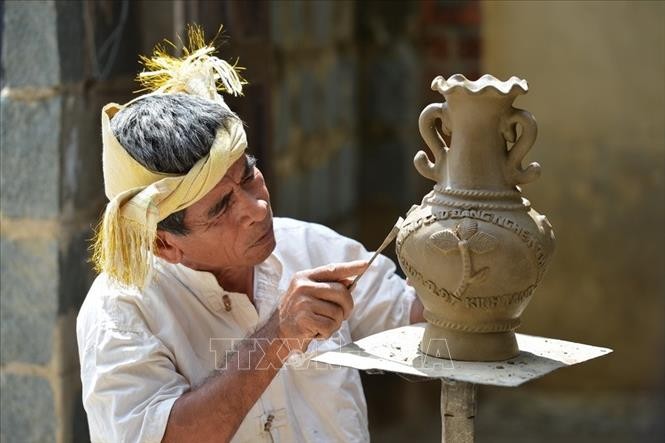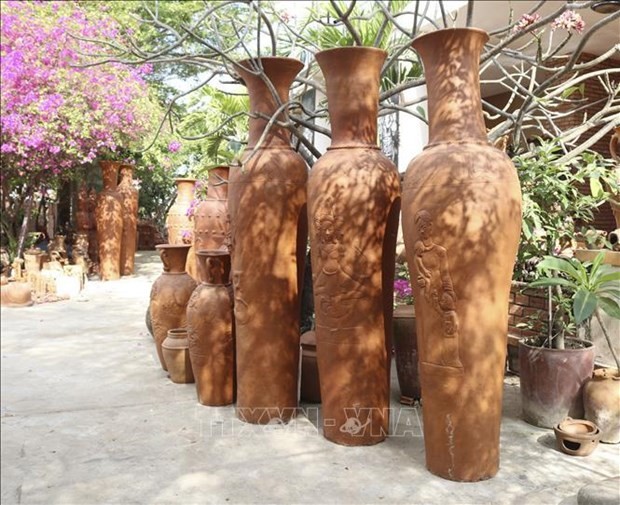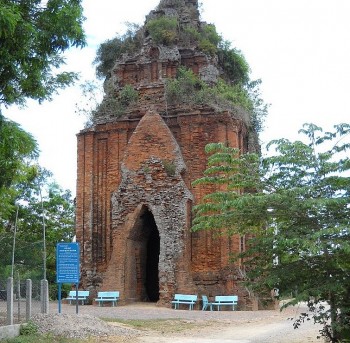Cham People’s Pottery Making Art Recognised by UNESCO as Heritage in Need of Urgent Safeguarding
 |
| For the Cham ethnic people, ceramics not only are used as daily utensils, but more importantly, they are an intermedia for them to connect with gods. Photo: VNA |
The art of pottery making of Cham ethnic people was inscribed in the list of intangible cultural heritage in need of urgent safeguarding by UNESCO on November 29, VNA reported.
The recognition was made at the 17th session of the Inter-governmental Committee for the Safeguarding of the Intangible Cultural Heritage in Rabat, Morocco, according to the Ministry of Culture, Sports and Tourism.
The pottery making of Cham people is the 15th intangible cultural heritage of Vietnam to be named in UNESCO lists.
Cham pottery products are mainly household utensils, worship objects, and handicrafts such as jars (called “jek”), pots (gok), food trays (cambak), and vases (bilaok).
Pottery making is considered a demonstration of Cham women’s creativity on the basis of their community’s knowledge.
Notably, instead of using turntables, Cham women move themselves backward around blocks of clay to shape objects. The products are not laid with enamel but dried and baked outdoor in wood and rice straw fires at about 800 degrees Celsius for seven - eight hours.
Clay is sourced from the Hamu Tanu Halan field on the banks of the Quao River in Bau Truc village and the clay pit of Xuan Quang village, about 3km to the northwest of Binh Duc village, the central province of Ninh Thuan.
Despite preservation efforts, the pottery making is still at risk of disintegration due to the urbanisation process’s impact on the access to raw materials, the slow adaptation to the market economy, and young people’s lack of interest in the craft.
 |
| Floor vases produced in Cham Bau Truc pottery village. Photo: VNA |
In which, Bau Truc, located in Ninh Thuan’s Ninh Phuoc district, is among the oldest pottery making villages in Southeast Asia. It is home to more than 400 households engaging in pottery. There are one cooperative and 12 production facilities, creating jobs for over 600 workers.
For all types of products, shaping clay by hand without foot-powered wheels, no glazing and open-air firing are rudimentary pottery methods that distinguish Bau Truc pottery from products of other traditional craft villages.
Bau Truc potters’ traditional technique is a process of three steps: preparing raw materials; shaping clay, decorating and drying; and open-air firing.
 | Mysterious Writing Discovered on Ancient Cham Stone Stele in Quang Nam While first found in 1997, the writing has not be deciphered until now! |
 | Cham People in Binh Thuan Province Celebrate Kate Festival Kate festival this year in Ninh Thuan attracts a large number of people and tourists to have fun as well as enjoy the traditional culture ... |
 | Two Heritage Pieces of Vietnam Named in Asia-Pacific Documentary Heritage List They are a collection of handwritten Chinese and Nom documents in Ha Tinh province and the 78 “ma nhai” steles on Ngu Hanh Son Mountain ... |
Recommended
 Viet's Home
Viet's Home
Zhi Shan Foundation Expands Medical Care for Disadvantaged Children and Mothers
 Viet's Home
Viet's Home
Rebuilding Homes in Storm-hit Areas to be Completed Before January 15, 2026
 Viet's Home
Viet's Home
COV/United States Supports Students Affected By Storms And Floods in Dak Lak
 Viet's Home
Viet's Home
Comprehensive Review of Overseas Vietnamese Affairs To Takes Place on December 25
 Viet's Home
Viet's Home
US Government Aid Supports Natural Disasters Recovery in Gia Lai Province
 Viet's Home
Viet's Home
Launch of “Student-Friendly Health Corner” In Vietnam
 Viet's Home
Viet's Home
Handover of First House Under “Quang Trung Campaign”
 Viet's Home
Viet's Home


